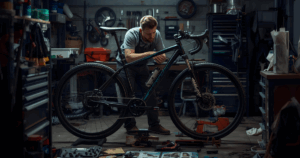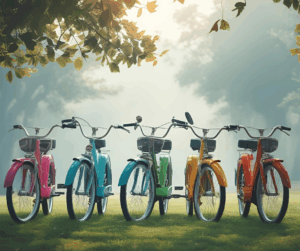Bike riding with your kids can be one of the most rewarding family activities, blending the thrill of adventure, the benefits of exercise, and the joy of shared experiences into one outing. The freedom of the open path, the laughter of your children as they pedal beside you, and the chance to explore new places together create moments that stick in the memory for years. But unlike solo cycling, family rides require a more thoughtful approach.
When you have young riders involved, considerations like safety, pacing, route choice, and equipment become even more important. The difference between a stressful day out and a smooth, enjoyable adventure often comes down to preparation. In this guide, we’ll walk through 17 tried-and-tested tips that will help you plan safe, fun, and stress-free bike riding trips with your kids, so every ride becomes a memory worth keeping.
1. Choose the Right Bikes for Everyone
The success of your family bike riding starts with proper equipment, and that begins with having the right-sized bikes. A bike that’s too big or too small can lead to discomfort, loss of control, and even injuries. For children, the general rule is that they should be able to sit on the saddle with their feet flat on the ground, and the handlebars should be at a comfortable reach without forcing them to hunch forward. Younger riders may benefit from balance bikes, which help develop coordination without the complication of pedals.
If your kids have already mastered riding on two wheels, you might look for lightweight frames that make it easier for them to handle hills or longer distances. Adjustable seat posts and handlebars allow the bike to grow with them, saving you from frequent replacements. Parents who plan longer routes might consider e-bikes to help carry cargo or assist with towing a trailer, ensuring no one is too tired to enjoy the day.
2. Always Wear Helmets
When it comes to bike riding safety, helmets are your family’s best line of defense. They’re not just a precaution for major accidents—they also protect against the smaller falls that are common with young cyclists. Choosing the right helmet is just as important as wearing one. Look for models that meet recognized safety standards like CPSC, Snell, or ASTM.
The helmet should sit level on the head, cover the forehead, and fit snugly without tilting back or forward. It’s worth involving your kids in picking out their helmets—letting them choose colors or patterns can make them more eager to wear them. And most importantly, lead by example: if your children see you wearing yours during every bike riding trip, they’ll be more likely to do the same without argument.
3. Plan a Kid-Friendly Route
Route choice can make or break your bike riding experience with kids. Young riders can be easily intimidated by busy streets, uneven terrain, or steep climbs. Look for traffic-free paths, park trails, or waterfront routes that are smooth, wide, and scenic. These not only provide a safer environment but also keep children engaged with interesting sights along the way. A route dotted with playgrounds, rest stops, or cafes can also help maintain enthusiasm.
If you’re venturing into a new area, scout the path in advance or use cycling-specific mapping tools like Komoot or Ride with GPS to check elevation changes and hazards. Remember, the goal isn’t to push limits—it’s to make bike riding feel enjoyable and accessible for everyone.
4. Teach Road Safety Early
Even if your family rides are mostly on dedicated paths, it’s important to teach road safety from the start. You never know when you might have to cross an intersection or share a lane with vehicles. Basic skills—like stopping at all crossings, using hand signals, checking for traffic, and riding in a straight line—should be second nature for your kids. Turn these lessons into interactive games during your bike riding outings. For example, let your child “play traffic cop” by signaling turns for the group, or practice quick stops in a safe, open area. These skills build confidence and prepare them for more complex riding environments as they grow.
5. Use the Right Safety Gear
While helmets are essential, other gear can significantly boost your family’s safety during bike riding. Bright, high-visibility clothing ensures drivers and other cyclists can spot you from a distance. Add front and rear lights even for daytime rides—low-angle sunlight or shaded areas can still reduce visibility. Reflective strips on helmets, shoes, or backpacks add another layer of safety. For parents riding in front or back, a handlebar-mounted mirror allows you to keep an eye on the group without constantly turning your head, helping maintain stability.
6. Invest in a Child Seat or Trailer
If you have younger kids who aren’t ready to pedal on their own, a well-designed child seat or trailer opens up more options for bike riding together. Rear-mounted seats keep children close, letting you chat and point out sights as you ride. Trailers offer more comfort, weather protection, and the ability to carry snacks, toys, or even picnic gear. Some models can convert into strollers, giving you flexibility if your outing includes walking trails or markets. Remember to check weight limits and ensure the attachment is properly secured before heading out.
7. Carry Plenty of Snacks and Water
Kids burn energy quickly, and nothing derails a bike riding trip faster than hunger or dehydration. Pack portable, easy-to-eat snacks like apple slices, granola bars, or trail mix. A reusable water bottle for each rider helps encourage hydration breaks. Consider using hydration backpacks for older kids—they’re fun to use and make sipping on the go much easier. Turning snack stops into mini picnics at scenic spots adds another layer of enjoyment to the day.
8. Dress for Comfort and Weather
Comfort is key for keeping kids happy during bike riding. Breathable fabrics help in warm weather, while lightweight layers work well in cooler conditions. A good rule is to dress in layers so you can adjust as the temperature changes. Padded cycling shorts reduce saddle soreness, especially on longer rides. On sunny days, don’t forget sunglasses and sunscreen—UV protection is just as important for kids as it is for adults. If rain is in the forecast, pack compact waterproof jackets so you can keep going without turning back.
9. Start with Short Distances
When introducing kids to bike riding, pacing their progress is essential. Long rides right away can lead to frustration or exhaustion. Instead, start with short, achievable distances that leave them wanting more. For instance, you might ride to a favorite park, have a picnic, and then head home. Over time, gradually extend the route to include new destinations. This steady build-up helps develop stamina without making the activity feel like a chore.
10. Take Frequent Breaks
Kids have shorter attention spans and energy reserves than adults, so scheduling regular stops is important. These breaks aren’t just for rest—they’re opportunities to explore, take photos, and enjoy the surroundings. On a bike riding day out, a quick stop to watch ducks in a pond or explore a small trail can be just as memorable as the ride itself. Plan these pauses into your route so they become an expected and enjoyable part of the journey.
11. Keep the Pace Relaxed
Remember, family bike riding isn’t a race. Set a comfortable pace that allows for conversation and doesn’t pressure slower riders to keep up. If one child is more confident, let them take turns riding at the front, while making sure less experienced riders stay in the middle where they’re protected. Encourage walking the bike up tough hills if needed—it’s about finishing the ride with smiles, not exhaustion.
12. Make It Fun with Games
Adding playful challenges or games into your bike riding trips can keep younger kids engaged. You could play “I Spy,” create a scavenger hunt, or give points for spotting certain animals or landmarks. For older children, try navigation games where they help guide the route using a map. These activities transform the ride from simple transport into an adventure.
13. Set Clear Rules
Rules help maintain order and safety, especially when multiple kids are involved. Before setting off on a bike riding trip, agree on simple guidelines: no sudden swerves, stop at every crossing, and always keep both hands on the handlebars unless signaling. Reinforce these rules gently during the ride to keep habits consistent.
14. Stay Together
It’s easy for enthusiastic riders to race ahead, but staying close is crucial for safety. The best formation for bike riding with kids is having one adult at the front and one at the back, with children in the middle. This setup ensures everyone is visible and prevents stragglers from falling behind. If you’re the solo adult, ride slightly ahead but at a slow pace so you can keep the group together.
15. Be Prepared for Emergencies
Unexpected problems can arise even on the best-planned rides. Carry a compact repair kit with tire levers, a spare tube, and a multi-tool. A small first-aid kit with plasters, antiseptic wipes, and an ice pack is also a good idea. Knowing how to handle minor issues on a bike riding outing—like a slipped chain or a scraped knee—can turn a potential disaster into just a short delay.
16. Encourage and Praise Your Kids
Positive reinforcement keeps kids motivated and builds their confidence in bike riding. Celebrate small achievements, whether it’s riding up a hill without stopping or remembering to signal at every turn. A simple “great job” or high-five can boost morale and make them eager for the next outing. You might also keep a family cycling log to track rides and milestones.
17. End on a High Note
Always finish your bike riding trips with something enjoyable. This could be ice cream, a picnic, or a stop at a favorite playground. Ending with a reward leaves kids associating cycling with positive experiences, making them more likely to look forward to your next family ride.
Conclusion
Bike riding with children is more than just an outdoor activity—it’s an investment in family connection, health, and lifelong skills. By choosing the right equipment, planning thoughtful routes, and keeping safety front and center, you can turn every ride into an adventure everyone enjoys. Whether you’re cruising along quiet park trails or venturing into new neighborhoods, these 17 tips will help you make the most of your family cycling days, ensuring they’re safe, fun, and full of memories worth cherishing.




